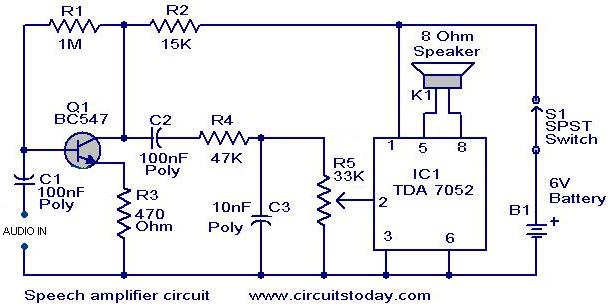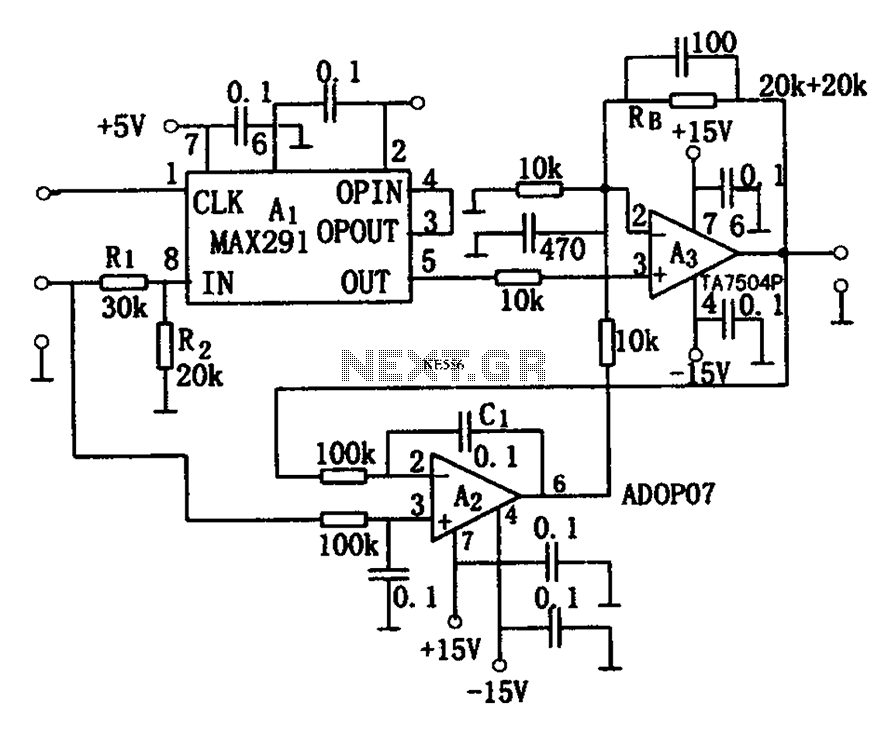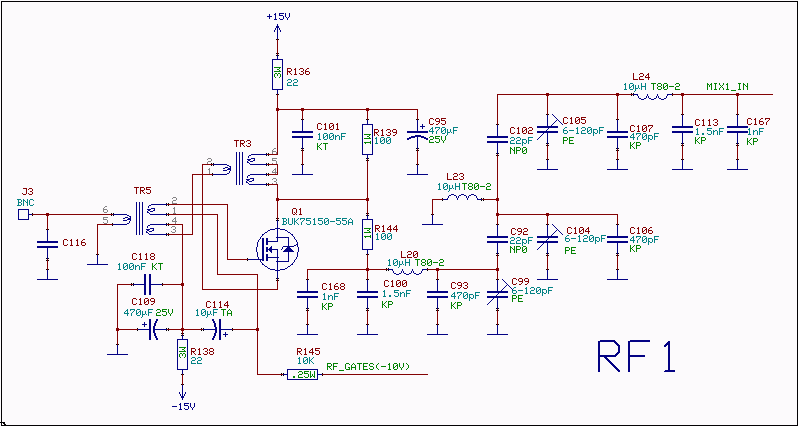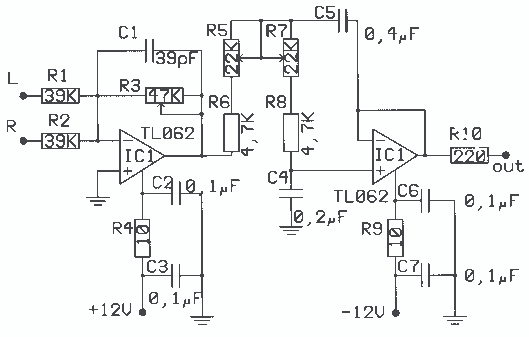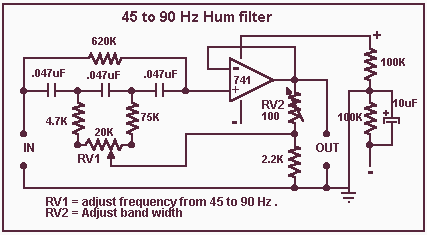
Speech Filter
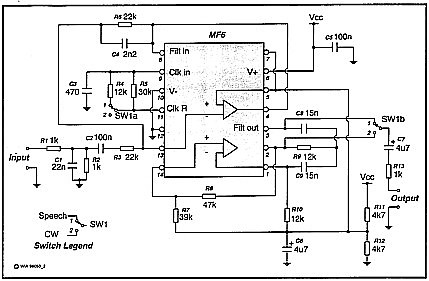
A simple circuit that can switch between a sharp cutoff frequency above 2.5 kHz and a narrow bandpass filter around 800 Hz. In the low-pass (LP) state, it is suitable for speech applications as the filter section of a direct conversion receiver. For continuous wave (CW) operation, the cutoff frequency is reduced to 800 Hz, and an additional high-pass (HP) section with a cutoff below 800 Hz is included to create a narrow bandpass filter centered at 800 Hz. The CW Morse beat note is adjusted to match the center frequency of the bandpass filter. The operation of the circuit is described in subsequent paragraphs. If any filter terminology is unfamiliar, readers are referred to the initial sections of the author's previous article (reference 1), which also elaborates on the types of filters utilized in this design. The circuit employs the National Semiconductor switched capacitor LP filter package type MF6, which consists of two operational amplifiers configured as a sixth-order Butterworth filter. The filter operates from its internal clock, which runs at 50 times the cutoff frequency. To achieve cutoff frequencies of 2.5 kHz and 800 Hz for the LP filter, the clock frequency is switched between 125 kHz and 40 kHz, respectively. As a sixth-order Butterworth filter, this switched capacitor filter has an attenuation slope of 36 dB per octave beyond the cutoff frequency. To create the 800 Hz high-pass filter, one of the operational amplifiers is configured as a second-order Chebyshev filter. This type of filter provides a theoretical attenuation of 17 dB at the first octave, which, while not as significant as the LP filter, effectively reduces audio noise or interference below the 800 Hz center frequency. Figure 1 illustrates the filter system in block diagram form. For speech applications, the LP filter operates independently. In CW mode, the cutoff frequency is lowered, and the output is routed through the HP filter section. Switched capacitor filters can produce spurious output signals when fed frequencies close to their clock frequency. To mitigate this, the switched capacitor filter is fed through a simple anti-alias filter that rolls off above 5 kHz. For circuit details, refer to Figure 2. The MF6 package operates on a split power rail configuration, with the center rail derived from a single DC supply using resistors R11 and R12. The supply voltage is not critical, and the circuit functions effectively on any well-filtered single DC supply between 8 and 14 volts. The clock frequency is determined by components C3, R4, and R5. Switch S1 selects between speech and CW modes, with contacts S1a adjusting the resistance in the circuit to modify the clock frequency and, consequently, the LP cutoff frequency. Components C8, C9, R7, R8, R9, and R10 comprise the HP Chebyshev active filter in conjunction with one of the internal operational amplifiers of the MF6 package. Switch contacts S1b connect the output either directly from the LP circuit or through the HP circuit. The non-inverting input of the second operational amplifier is internally connected to the center rail, necessitating the use of this amplifier in an inverting configuration. The roll-off above 5 kHz for the anti-alias filter is partially achieved by capacitor C4 in the amplifier feedback loop and capacitor C1 at the input. If desired, the filter can function as a standalone unit, with its input sourced from the output of a receiver or a transceiver's headphone jack. The filter's output is suitable for driving high-impedance headphones. To drive a loudspeaker, a power amplifier such as the LM380 or LM386 can be integrated. It is important to note that the load current of these power amplifiers varies significantly with changes in audio levels, necessitating a well-regulated power supply, ideally isolated from the filter's power supply. One characteristic of the switched capacitor filter is the presence of output components near the clock frequency. With the lowest cutoff at 800 Hz, these components do not fall below approximately 40 kHz and can be easily filtered out electrically. However, they remain outside the frequency range of interest.A simple circuit which is switchable between a sharp cut-off above 2. 5 kHz and a narrow bandpass around 800 Hz. In the low pass (LP) state it can be used on speech as the filter section of a direct conversion receiver. For CW operation, the cut-off frequency is lowered to 800 Hz and another high pass (HP) section with cut-off below 800 Hz
is added to form a narrow bandpass around 800 Hz. To use this. the CW Morse beat note is adjusted to the bandpass centre frequency. In the following paragraphs operation of the circuit is described. If filter terminology used appears unfamiliar, the reader is referred to the opening paragraphs of the writer`s previous article (reference 1). The article also discusses a little more about the types of filter employed here. The circuit makes use of the National Semiconductor switched capacitor LP filter package type MF6. which includes two operational amplifiers with the sixth order Butterworth filter. The filter is also operated from its own internal clock operating at 50 times the cut-off frequency. To achieve the 2. 5 kHz and 800 Hz LP cut-off, the clock frequency is switched between 125 kHz and 40 kHz respectively.
As a sixth order Butterworth, the switched capacitor filter has an attenuation slope beyond cut-off of 36 dB per octave. To produce the 800 Hz high pass, one of the operational amplifiers is connected as a second order Chebychev filter.
This type filter gives a theoretical attenuation at the first octave of 17 dB, not as great as the LP filter but quite effective in reducing audio noise or interference below the 800 Hz centre frequency. Figure 1 illustrates the filter system in block form. For speech, the LP filter is operated on its own. For CW its cut-off frequency is lowered and its output fed via the HP filter section. Switched capacitor filters produce spurious output signals if fed with a frequency close to their clock frequency.
To guard against any such signal coming from the receiver, the switched capacitor filter is fed via a simple anti-alias filter with a roll-off above 5 kHz. For circuit detail, refer to Figure 2. The MF6 package operates on a split power rail basis and a centre rail is derived from the single DC supply with resistors R11 and R12.
Supply voltage is not critical and the circuit works on any well-filtered single DC supply between 8 and 14 volts. The clock frequency is set by components C3, R4 and R5. Switch S1 selects speech or CW and its contacts S1a alter the resistance in the circuit to change the clock frequency and hence the LP cut-off frequency.
Components C8, C9, R7, R8, R9 and R10 make up the HP Chebychev active filter in conjunction with one of the MF6 internal operational amplifiers. Switch contacts S1b connect the output either direct from the LP circuit or via the HP circuit. The non-inverting input of the second operational amplifier is connected internally to centre rail, so this amplifier has had to be used in the inverting mode.
Roll-over above 5 kHz for the anti-alias filter is partly done by capacitor C4 in the amplifier feedback circuit and partly by capacitor C1 at the input. If required, the filter can be used as a stand-alone unit with its input fed from the output of a receiver or transceiver headphones jack.
The output of the filter is suitable to operate into high impedance headphones. To operate a loudspeaker, a power amplifier such as the LM380 or LM386 can be added. Of course, the load current of these power amplifiers swings widely with variation in audio level and they require a well regulated power source, preferably isolated from the filter supply. One characteristic of the switched capacitor filter is that there are output components near clock frequency.
With the lowest cut-off at 800 Hz, these components are no lower in frequency than around 40 kHz and could easily be electrically filtered out. However, as they are outside the frequency range of t 🔗 External reference
is added to form a narrow bandpass around 800 Hz. To use this. the CW Morse beat note is adjusted to the bandpass centre frequency. In the following paragraphs operation of the circuit is described. If filter terminology used appears unfamiliar, the reader is referred to the opening paragraphs of the writer`s previous article (reference 1). The article also discusses a little more about the types of filter employed here. The circuit makes use of the National Semiconductor switched capacitor LP filter package type MF6. which includes two operational amplifiers with the sixth order Butterworth filter. The filter is also operated from its own internal clock operating at 50 times the cut-off frequency. To achieve the 2. 5 kHz and 800 Hz LP cut-off, the clock frequency is switched between 125 kHz and 40 kHz respectively.
As a sixth order Butterworth, the switched capacitor filter has an attenuation slope beyond cut-off of 36 dB per octave. To produce the 800 Hz high pass, one of the operational amplifiers is connected as a second order Chebychev filter.
This type filter gives a theoretical attenuation at the first octave of 17 dB, not as great as the LP filter but quite effective in reducing audio noise or interference below the 800 Hz centre frequency. Figure 1 illustrates the filter system in block form. For speech, the LP filter is operated on its own. For CW its cut-off frequency is lowered and its output fed via the HP filter section. Switched capacitor filters produce spurious output signals if fed with a frequency close to their clock frequency.
To guard against any such signal coming from the receiver, the switched capacitor filter is fed via a simple anti-alias filter with a roll-off above 5 kHz. For circuit detail, refer to Figure 2. The MF6 package operates on a split power rail basis and a centre rail is derived from the single DC supply with resistors R11 and R12.
Supply voltage is not critical and the circuit works on any well-filtered single DC supply between 8 and 14 volts. The clock frequency is set by components C3, R4 and R5. Switch S1 selects speech or CW and its contacts S1a alter the resistance in the circuit to change the clock frequency and hence the LP cut-off frequency.
Components C8, C9, R7, R8, R9 and R10 make up the HP Chebychev active filter in conjunction with one of the MF6 internal operational amplifiers. Switch contacts S1b connect the output either direct from the LP circuit or via the HP circuit. The non-inverting input of the second operational amplifier is connected internally to centre rail, so this amplifier has had to be used in the inverting mode.
Roll-over above 5 kHz for the anti-alias filter is partly done by capacitor C4 in the amplifier feedback circuit and partly by capacitor C1 at the input. If required, the filter can be used as a stand-alone unit with its input fed from the output of a receiver or transceiver headphones jack.
The output of the filter is suitable to operate into high impedance headphones. To operate a loudspeaker, a power amplifier such as the LM380 or LM386 can be added. Of course, the load current of these power amplifiers swings widely with variation in audio level and they require a well regulated power source, preferably isolated from the filter supply. One characteristic of the switched capacitor filter is that there are output components near clock frequency.
With the lowest cut-off at 800 Hz, these components are no lower in frequency than around 40 kHz and could easily be electrically filtered out. However, as they are outside the frequency range of t 🔗 External reference

